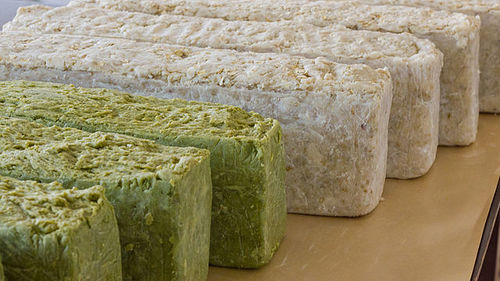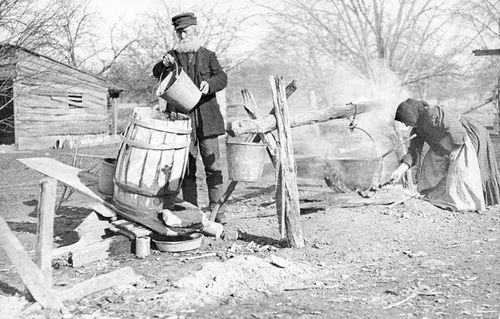Lye: Difference between revisions
(changed list of steps to a numbered one) |
m (→Uses) |
||
| (15 intermediate revisions by 2 users not shown) | |||
| Line 1: | Line 1: | ||
{{Category=Materials}} | {{Category=Materials}} | ||
http://en.wikipedia.org/wiki/Lye | [[File:Soap_making_1884.jpg|500px|thumb|right|Recollections of domestic life. Soap making, Antigo (Wisconsin), 1884. The farmer is pouring water into the ash barrel to make lye; his wife is boiling a kettle of fat. Lye and fat produce soft soap.]] | ||
[[File: 640px-Soap logs all natural.jpg |500px|thumb|right| Logs of soap made from lye extracted from [[Wood Ash|wood ash]]. ]] | |||
[http://en.wikipedia.org/wiki/Lye Lye], also known as NaOH, sodium hydroxide, or caustic soda, is used in making soap. Caustic potash, or potassium hydroxide (KOH), is also called lye and can easily be made at home. It can also be used in the production of [[biodiesel]], although the recipe will have to be adjusted somewhat. | |||
==Basic Recipe== | ==Basic Recipe== | ||
# from hard wood ash | # from hard [[Wood Ash|wood ash]] | ||
# extraction with soft water | # extraction with soft water; filter it at the same time | ||
# boil | # boil off water | ||
# voila ! | # voila! The whitish powder is mostly potassium hydroxide | ||
==From the [[Household Cyclopedia]] (1881)== | |||
To make saponaceous Lye for washing: boil together in a sufficient quantity of water, 1 gal. of good wood-ashes and 2 or 3 handfuls of fresh-burnt lime. Leave the lixivium at rest till the extraneous matters have been deposited at the bottom, or thrown to the surface to be skimmed off. Then draw off the pure lixivium, add to it oil, to about a thirtieth or fortieth part of its own quantity. The mixture will be a liquor white us milk, capable of frothing like soap-water, and in dilution with water perfectly fit to communicate sufficient whiteness to linen. This liquor may be prepared from wood-ashes of all sorts, and from rancid grease, oil or butter. It is therefore highly worthy the attention of the economist. When the ashes are suspected to be unusually deficient in alkali, a small addition of pulverized potash or soda may be made to the lixivium. | |||
==Uses== | ==Uses== | ||
* | * to make [[biodiesel]] from various oils | ||
* soapmaking | * soapmaking | ||
* in food, such as for lye rolls and pretzels | * in food, such as for lye rolls and pretzels | ||
* for [[geopolymers]] | * key ingredient for [[geopolymers]] | ||
* useful for breaking down cell walls as a preliminary to extracting phytochemicals from plants | * useful for breaking down cell walls as a preliminary step to extracting phytochemicals from plants | ||
* oven cleaner and drain opener | * oven cleaner and drain opener | ||
* disinfectant | |||
* removal of hair from animal hides in the tanning process | |||
* potentially for [[Geopolymers |geopolymer]] bricks and other construction | |||
==Safety considerations== | |||
Lye is highly corrosive and needs to be handled with care (remember that scene from ''Fight Club''?). If you get it on your skin, immediately pour plenty of vinegar on it; this will neutralise it. | |||
Lye should be kept in [[polyethylene from Ethanol|HDPE]] containers, as it will burn through anything else. | |||
==Useful Links== | |||
* Journey To Forever: [http://journeytoforever.org/biodiesel_ashlye.html "Making lye from wood ash"] | |||
* Life Unplugged: [http://www.lifeunplugged.net/everythingelse/make-lye-from-wood-ash.aspx "How to Make Lye from Wood Ash"] | |||
* WikiHow: [http://www.wikihow.com/Make-Lye "How to Make Lye"] | |||
* Caveman Chemistry: [http://cavemanchemistry.com/oldcave/projects/lime/ "Lime and Lye: Two Strong Alkalis"] | |||
Latest revision as of 01:20, 21 July 2016

Lye, also known as NaOH, sodium hydroxide, or caustic soda, is used in making soap. Caustic potash, or potassium hydroxide (KOH), is also called lye and can easily be made at home. It can also be used in the production of biodiesel, although the recipe will have to be adjusted somewhat.
Basic Recipe
- from hard wood ash
- extraction with soft water; filter it at the same time
- boil off water
- voila! The whitish powder is mostly potassium hydroxide
From the Household Cyclopedia (1881)
To make saponaceous Lye for washing: boil together in a sufficient quantity of water, 1 gal. of good wood-ashes and 2 or 3 handfuls of fresh-burnt lime. Leave the lixivium at rest till the extraneous matters have been deposited at the bottom, or thrown to the surface to be skimmed off. Then draw off the pure lixivium, add to it oil, to about a thirtieth or fortieth part of its own quantity. The mixture will be a liquor white us milk, capable of frothing like soap-water, and in dilution with water perfectly fit to communicate sufficient whiteness to linen. This liquor may be prepared from wood-ashes of all sorts, and from rancid grease, oil or butter. It is therefore highly worthy the attention of the economist. When the ashes are suspected to be unusually deficient in alkali, a small addition of pulverized potash or soda may be made to the lixivium.
Uses
- to make biodiesel from various oils
- soapmaking
- in food, such as for lye rolls and pretzels
- key ingredient for geopolymers
- useful for breaking down cell walls as a preliminary step to extracting phytochemicals from plants
- oven cleaner and drain opener
- disinfectant
- removal of hair from animal hides in the tanning process
- potentially for geopolymer bricks and other construction
Safety considerations
Lye is highly corrosive and needs to be handled with care (remember that scene from Fight Club?). If you get it on your skin, immediately pour plenty of vinegar on it; this will neutralise it.
Lye should be kept in HDPE containers, as it will burn through anything else.
Useful Links
- Journey To Forever: "Making lye from wood ash"
- Life Unplugged: "How to Make Lye from Wood Ash"
- WikiHow: "How to Make Lye"
- Caveman Chemistry: "Lime and Lye: Two Strong Alkalis"
